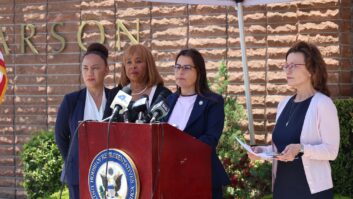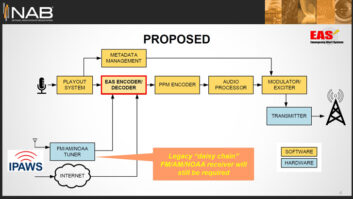FEMA, in coordination with the Federal Communications Commission, will conduct a nationwide test of the Emergency Alert System and Wireless Emergency Alerts this fall.
The national test will consist of two portions, testing WEA and EAS capabilities. Both tests are scheduled to begin at approximately 2:20 p.m. ET on Wednesday, Oct. 4.
The WEA portion of the test will be directed to all consumer cell phones. “This will be the third nationwide test, but the second test to all cellular devices,” said FEMA in a press release. “The test message will display in either English or in Spanish, depending on the language settings of the wireless handset.”
The EAS portion of the test will be sent to radios and televisions. This will be the seventh nationwide EAS test.
The WEA portion of the test will be initiated using FEMA’s Integrated Public Alert and Warning System (IPAWS), a centralized internet-based system administered by FEMA that enables authorities to send authenticated emergency messages to the public through multiple communications networks. The WEA test will be administered via a code sent to cell phones.
Beginning at approximately 2:20 p.m. ET, cell towers will broadcast the test for approximately 30 minutes. During this time, WEA-compatible wireless phones that are switched on, within range of an active cell tower, and whose wireless provider participates in WEA, should be capable of receiving the test message. All wireless phones should receive the message only once.
“WEA alerts are created and sent by authorized federal, state, local, tribal and territorial government agencies through IPAWS to participating wireless providers, which deliver the alerts to compatible handsets in geo-targeted areas,” said FEMA. “To help ensure that these alerts are accessible to the entire public, including people with disabilities, the alerts are accompanied by a unique tone and vibration.”
In September of 2022 the FCC partnered with 37 emergency management agencies to conduct localized Wireless Emergency Alert tests. (Read its post-test findings.)
This year the EAS message will be disseminated as an IP-based Common Alerting Protocol (CAP) message. Earlier this year, the FCC updated its EAS rules to take advantage of the latest technologies in order to reach more people, particularly people with disabilities. The commission believes that required greater use of CAP format alerts will result in more understandable and informative messages. Beginning in December 2023, broadcasters will be required to implement the new CAP alert polling and prioritization rules.
[Related: “EAS Rules Modifications Put Broadcasters on the Clock to Comply“]
The EAS portion of the test is scheduled to last approximately one minute and will be conducted with the participation of broadcasters. FEMA said the test message will be similar to the regular monthly EAS test messages with which the public is familiar. It will state: “This is a nationwide test of the Emergency Alert System, issued by the Federal Emergency Management Agency, covering the United States from 14:20 to 14:50 hours ET. This is only a test. No action is required by the public.”
The most recent national EAS test was in 2021 and showed improvement over two years prior, according to a subsequent report by the FCC. The 2021 test used only the broadcast-based distribution system, the so-called “EAS daisy chain,” and did not involve the internet-based IPAWS system.
In case the Oct. 4 test is postponed due to widespread severe weather or other significant events, FEMA said the back-up testing date is Oct. 11.







